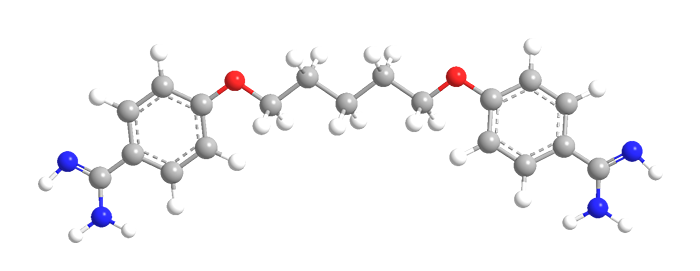What molecule am I?


Pentamidine, particularly as its diisethionate (di-2-hydroxyethanesulfonate) salt, is used to treat several infectious bacterial diseases. It has been used to treat African trypanosomiasis since 1937 and leishmaniasis since 1940. A US patent issued to British drug company May & Baker in 1946 describes its synthesis. It is usually administered by injection or inhalation.
Gram-negative bacteria, which have two sets of membranes, are difficult to control with standard antibiotics. Eric D. Brown and co-workers at McMaster University (Hamilton, ON) discovered that pentamidine can weaken the outer membrane of multidrug-resistant Gram-negative bacteria such as Acinetobacter baumannii to allow antibiotics to penetrate the more permeable inner membrane.
This finding, if verified by clinical studies, should help decrease hospital-acquired infections caused by A. baumannii and other drug-resistant species. Because regulatory agencies consider pentamidine safe in humans, its registration for this use could be fast-tracked.
MOTW Update
Chlorpyrifos was the Molecule of the Week for November 8, 2010. Toward the end of the Obama administration, the US Environmental Protection Agency issued biological evaluations of three insecticides, including chlorpyrifos, on endangered species. Now, these products’ manufacturers are pressuring the agency to rescind the evaluations on the basis that they are flawed.

Learn more about this molecule from CAS, the most authoritative and comprehensive source for chemical information.
Molecule of the Week needs your suggestions!
If your favorite molecule is not in our archive, please send us a message. The molecule can be notable for its current or historical importance or for any quirky reason. Thank you!
Stay Ahead of the Chemistry Curve
Learn how ACS can help you stay ahead in the world of chemistry.

